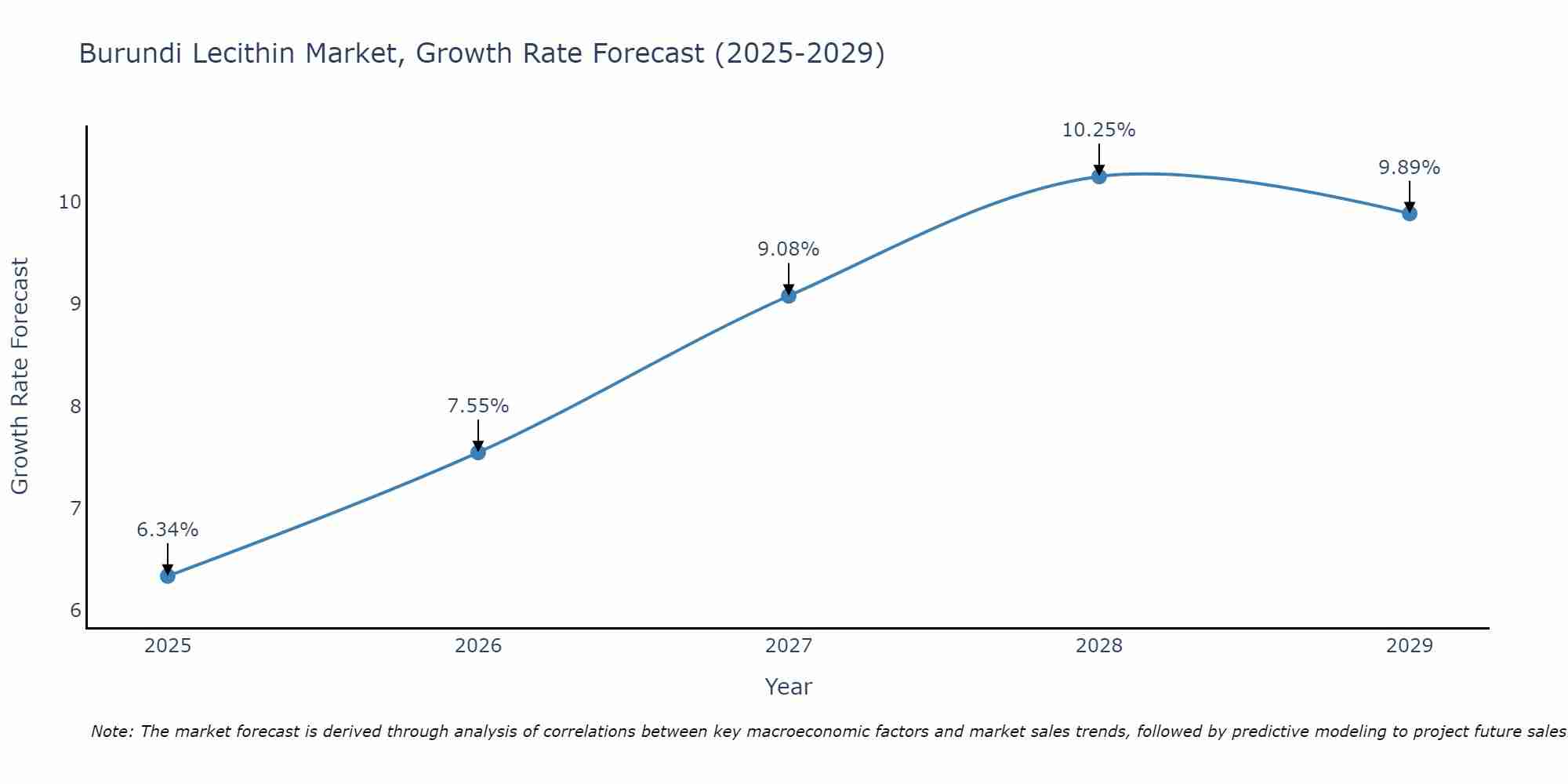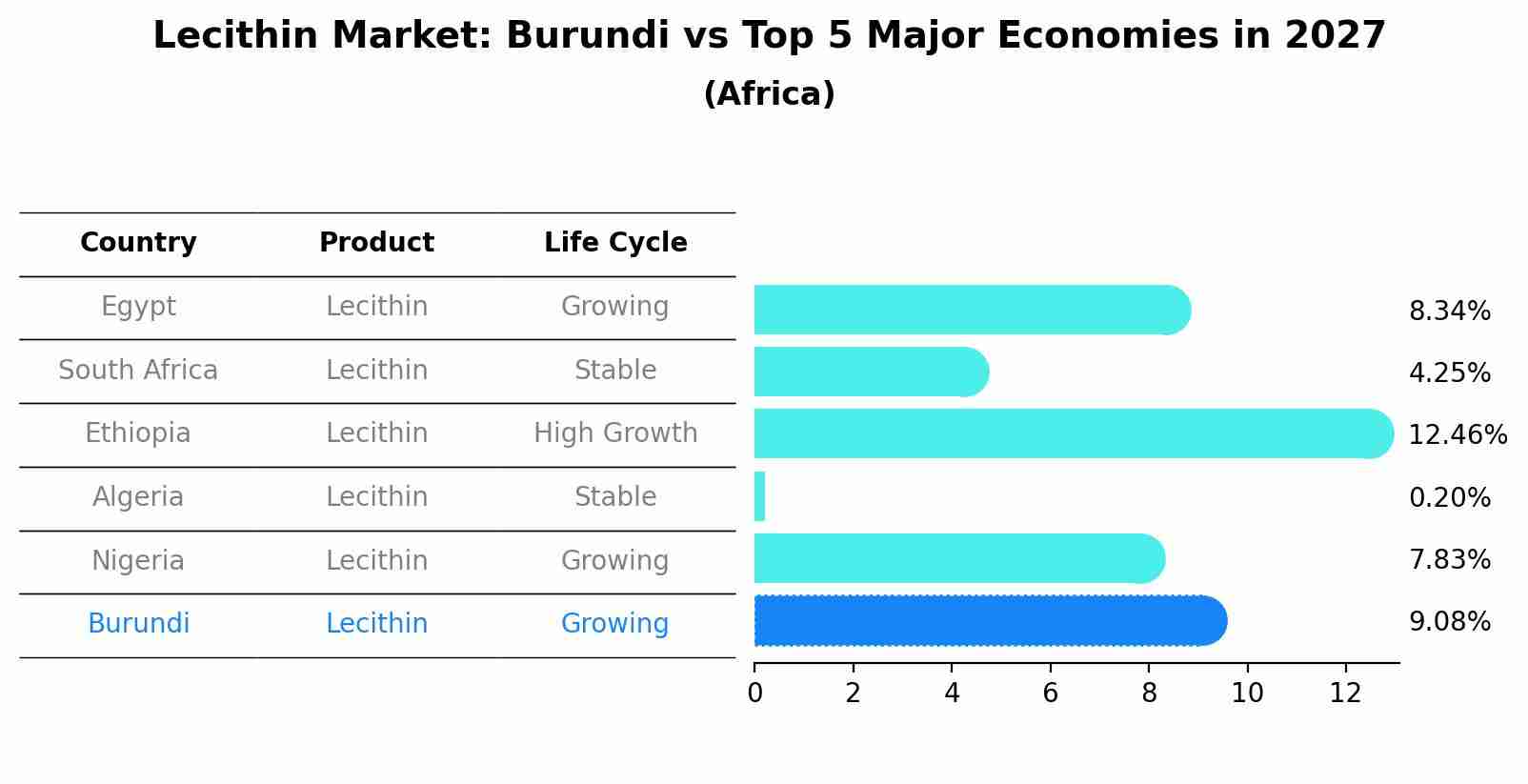Burundi Lecithin Market (2025-2031) | Analysis, Value, Trends, Revenue, Companies, Industry, Growth, Segmentation, Size, Outlook, Share & Forecast
| Product Code: ETC5359514 | Publication Date: Nov 2023 | Updated Date: Oct 2025 | Product Type: Market Research Report | |
| Publisher: 6Wresearch | Author: Bhawna Singh | No. of Pages: 60 | No. of Figures: 30 | No. of Tables: 5 |
Burundi Lecithin Market Size Growth Rate
The Burundi Lecithin Market is projected to witness mixed growth rate patterns during 2025 to 2029. The growth rate begins at 6.34% in 2025, climbs to a high of 10.25% in 2028, and moderates to 9.89% by 2029.

Lecithin Market: Burundi vs Top 5 Major Economies in 2027 (Africa)
By 2027, Burundi's Lecithin market is forecasted to achieve a growing growth rate of 9.08%, with Egypt leading the Africa region, followed by South Africa, Ethiopia, Algeria and Nigeria.

Burundi Lecithin Market Overview
The lecithin market in Burundi caters to the food, pharmaceutical, and cosmetics industries, where it is used as an emulsifier and additive. The market is growing due to the rising awareness of lecithin`s health benefits and its versatile applications.
Drivers of the market
The Lecithin market in Burundi is driven by the increasing use of lecithin as an emulsifier and stabilizer in the food and beverage industry. Lecithin is widely used in processed foods, bakery products, and dietary supplements due to its ability to improve texture and shelf life. The growing demand for processed foods and the trend toward healthier dietary options contribute to the markets expansion. Additionally, the use of lecithin in pharmaceuticals and cosmetics supports its market growth.
Challenges of the market
The Lecithin market in Burundi encounters challenges related to the sourcing and availability of raw materials. Limited local production and high import costs can impact the pricing and supply of lecithin. Additionally, there is a need for more advanced processing technologies to improve the quality and functionality of lecithin products. The market also faces competition from alternative emulsifiers and fluctuating demand from various end-use industries.
Government Policy of the market
In the Lecithin market, the Burundian government focuses on food safety and agricultural policies. Regulations are in place to ensure that lecithin used in food products meets safety standards and is sourced from reputable suppliers. The government also supports the local production of lecithin through agricultural incentives.
Key Highlights of the Report:
- Burundi Lecithin Market Outlook
- Market Size of Burundi Lecithin Market, 2024
- Forecast of Burundi Lecithin Market, 2031
- Historical Data and Forecast of Burundi Lecithin Revenues & Volume for the Period 2021-2031
- Burundi Lecithin Market Trend Evolution
- Burundi Lecithin Market Drivers and Challenges
- Burundi Lecithin Price Trends
- Burundi Lecithin Porter`s Five Forces
- Burundi Lecithin Industry Life Cycle
- Historical Data and Forecast of Burundi Lecithin Market Revenues & Volume By Source for the Period 2021-2031
- Historical Data and Forecast of Burundi Lecithin Market Revenues & Volume By Soy for the Period 2021-2031
- Historical Data and Forecast of Burundi Lecithin Market Revenues & Volume By Sunflower for the Period 2021-2031
- Historical Data and Forecast of Burundi Lecithin Market Revenues & Volume By Rapeseed for the Period 2021-2031
- Historical Data and Forecast of Burundi Lecithin Market Revenues & Volume By Others for the Period 2021-2031
- Historical Data and Forecast of Burundi Lecithin Market Revenues & Volume By End-use for the Period 2021-2031
- Historical Data and Forecast of Burundi Lecithin Market Revenues & Volume By Convenience Food for the Period 2021-2031
- Historical Data and Forecast of Burundi Lecithin Market Revenues & Volume By Bakery for the Period 2021-2031
- Historical Data and Forecast of Burundi Lecithin Market Revenues & Volume By Confectionary for the Period 2021-2031
- Historical Data and Forecast of Burundi Lecithin Market Revenues & Volume By Pharmaceutical for the Period 2021-2031
- Historical Data and Forecast of Burundi Lecithin Market Revenues & Volume By Personal Care And Cosmetics for the Period 2021-2031
- Historical Data and Forecast of Burundi Lecithin Market Revenues & Volume By Animal Feed for the Period 2021-2031
- Historical Data and Forecast of Burundi Lecithin Market Revenues & Volume By Other Industrial for the Period 2021-2031
- Historical Data and Forecast of Burundi Lecithin Market Revenues & Volume By Form for the Period 2021-2031
- Historical Data and Forecast of Burundi Lecithin Market Revenues & Volume By Liquid for the Period 2021-2031
- Historical Data and Forecast of Burundi Lecithin Market Revenues & Volume By Powder for the Period 2021-2031
- Historical Data and Forecast of Burundi Lecithin Market Revenues & Volume By Granules for the Period 2021-2031
- Burundi Lecithin Import Export Trade Statistics
- Market Opportunity Assessment By Source
- Market Opportunity Assessment By End-use
- Market Opportunity Assessment By Form
- Burundi Lecithin Top Companies Market Share
- Burundi Lecithin Competitive Benchmarking By Technical and Operational Parameters
- Burundi Lecithin Company Profiles
- Burundi Lecithin Key Strategic Recommendations
Frequently Asked Questions About the Market Study (FAQs):
1 Executive Summary |
2 Introduction |
2.1 Key Highlights of the Report |
2.2 Report Description |
2.3 Market Scope & Segmentation |
2.4 Research Methodology |
2.5 Assumptions |
3 Burundi Lecithin Market Overview |
3.1 Burundi Country Macro Economic Indicators |
3.2 Burundi Lecithin Market Revenues & Volume, 2021 & 2031F |
3.3 Burundi Lecithin Market - Industry Life Cycle |
3.4 Burundi Lecithin Market - Porter's Five Forces |
3.5 Burundi Lecithin Market Revenues & Volume Share, By Source, 2021 & 2031F |
3.6 Burundi Lecithin Market Revenues & Volume Share, By End-use, 2021 & 2031F |
3.7 Burundi Lecithin Market Revenues & Volume Share, By Form, 2021 & 2031F |
4 Burundi Lecithin Market Dynamics |
4.1 Impact Analysis |
4.2 Market Drivers |
4.2.1 Increasing consumer awareness about the health benefits of lecithin |
4.2.2 Growing demand for natural and organic ingredients in food and pharmaceutical industries |
4.2.3 Rise in the use of lecithin as an emulsifier in various food products |
4.3 Market Restraints |
4.3.1 Fluctuating prices of raw materials used in lecithin production |
4.3.2 Limited availability of raw materials in Burundi |
4.3.3 Lack of awareness about lecithin and its benefits in the local market |
5 Burundi Lecithin Market Trends |
6 Burundi Lecithin Market Segmentations |
6.1 Burundi Lecithin Market, By Source |
6.1.1 Overview and Analysis |
6.1.2 Burundi Lecithin Market Revenues & Volume, By Soy, 2021-2031F |
6.1.3 Burundi Lecithin Market Revenues & Volume, By Sunflower, 2021-2031F |
6.1.4 Burundi Lecithin Market Revenues & Volume, By Rapeseed, 2021-2031F |
6.1.5 Burundi Lecithin Market Revenues & Volume, By Others, 2021-2031F |
6.2 Burundi Lecithin Market, By End-use |
6.2.1 Overview and Analysis |
6.2.2 Burundi Lecithin Market Revenues & Volume, By Convenience Food, 2021-2031F |
6.2.3 Burundi Lecithin Market Revenues & Volume, By Bakery, 2021-2031F |
6.2.4 Burundi Lecithin Market Revenues & Volume, By Confectionary, 2021-2031F |
6.2.5 Burundi Lecithin Market Revenues & Volume, By Pharmaceutical, 2021-2031F |
6.2.6 Burundi Lecithin Market Revenues & Volume, By Personal Care And Cosmetics, 2021-2031F |
6.2.7 Burundi Lecithin Market Revenues & Volume, By Animal Feed, 2021-2031F |
6.3 Burundi Lecithin Market, By Form |
6.3.1 Overview and Analysis |
6.3.2 Burundi Lecithin Market Revenues & Volume, By Liquid, 2021-2031F |
6.3.3 Burundi Lecithin Market Revenues & Volume, By Powder, 2021-2031F |
6.3.4 Burundi Lecithin Market Revenues & Volume, By Granules, 2021-2031F |
7 Burundi Lecithin Market Import-Export Trade Statistics |
7.1 Burundi Lecithin Market Export to Major Countries |
7.2 Burundi Lecithin Market Imports from Major Countries |
8 Burundi Lecithin Market Key Performance Indicators |
8.1 Number of new product launches containing lecithin |
8.2 Percentage increase in the use of lecithin in food and pharmaceutical products |
8.3 Growth in the number of local manufacturers producing lecithin |
9 Burundi Lecithin Market - Opportunity Assessment |
9.1 Burundi Lecithin Market Opportunity Assessment, By Source, 2021 & 2031F |
9.2 Burundi Lecithin Market Opportunity Assessment, By End-use, 2021 & 2031F |
9.3 Burundi Lecithin Market Opportunity Assessment, By Form, 2021 & 2031F |
10 Burundi Lecithin Market - Competitive Landscape |
10.1 Burundi Lecithin Market Revenue Share, By Companies, 2024 |
10.2 Burundi Lecithin Market Competitive Benchmarking, By Operating and Technical Parameters |
11 Company Profiles |
12 Recommendations | 13 Disclaimer |
- Single User License$ 1,995
- Department License$ 2,400
- Site License$ 3,120
- Global License$ 3,795
Search
Thought Leadership and Analyst Meet
Our Clients
Related Reports
- Canada Oil and Gas Market (2026-2032) | Share, Segmentation, Value, Industry, Trends, Forecast, Analysis, Size & Revenue, Growth, Competitive Landscape, Outlook, Companies
- Germany Breakfast Food Market (2026-2032) | Industry, Share, Growth, Size, Companies, Value, Analysis, Revenue, Trends, Forecast & Outlook
- Australia Briquette Market (2025-2031) | Growth, Size, Revenue, Forecast, Analysis, Trends, Value, Share, Industry & Companies
- Vietnam System Integrator Market (2025-2031) | Size, Companies, Analysis, Industry, Value, Forecast, Growth, Trends, Revenue & Share
- ASEAN and Thailand Brain Health Supplements Market (2025-2031) | Strategy, Consumer Insights, Analysis, Investment Trends, Opportunities, Growth, Size, Share, Industry, Revenue, Segments, Value, Segmentation, Supply, Forecast, Restraints, Outlook, Competition, Drivers, Trends, Demand, Pricing Analysis, Competitive, Strategic Insights, Companies, Challenges
- ASEAN Bearings Market (2025-2031) | Strategy, Consumer Insights, Analysis, Investment Trends, Opportunities, Growth, Size, Share, Industry, Revenue, Segments, Value, Segmentation, Supply, Forecast, Restraints, Outlook, Competition, Drivers, Trends, Demand, Pricing Analysis, Competitive, Strategic Insights, Companies, Challenges
- Europe Flooring Market (2025-2031) | Outlook, Share, Industry, Trends, Forecast, Companies, Revenue, Size, Analysis, Growth & Value
- Saudi Arabia Manlift Market (2025-2031) | Outlook, Size, Growth, Trends, Companies, Industry, Revenue, Value, Share, Forecast & Analysis
- Uganda Excavator, Crane, and Wheel Loaders Market (2025-2031) | Strategy, Consumer Insights, Analysis, Investment Trends, Opportunities, Growth, Size, Share, Industry, Revenue, Segments, Value, Segmentation, Supply, Forecast, Restraints, Outlook, Competition, Drivers, Trends, Demand, Pricing Analysis, Competitive, Strategic Insights, Companies, Challenges
- Rwanda Excavator, Crane, and Wheel Loaders Market (2025-2031) | Strategy, Consumer Insights, Analysis, Investment Trends, Opportunities, Growth, Size, Share, Industry, Revenue, Segments, Value, Segmentation, Supply, Forecast, Restraints, Outlook, Competition, Drivers, Trends, Demand, Pricing Analysis, Competitive, Strategic Insights, Companies, Challenges
Industry Events and Analyst Meet
Whitepaper
- Middle East & Africa Commercial Security Market Click here to view more.
- Middle East & Africa Fire Safety Systems & Equipment Market Click here to view more.
- GCC Drone Market Click here to view more.
- Middle East Lighting Fixture Market Click here to view more.
- GCC Physical & Perimeter Security Market Click here to view more.
6WResearch In News
- Doha a strategic location for EV manufacturing hub: IPA Qatar
- Demand for luxury TVs surging in the GCC, says Samsung
- Empowering Growth: The Thriving Journey of Bangladesh’s Cable Industry
- Demand for luxury TVs surging in the GCC, says Samsung
- Video call with a traditional healer? Once unthinkable, it’s now common in South Africa
- Intelligent Buildings To Smooth GCC’s Path To Net Zero


















